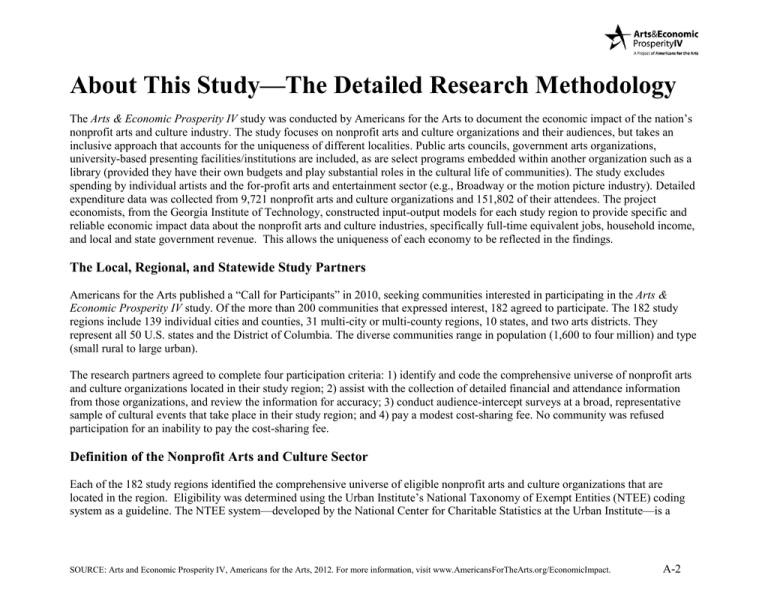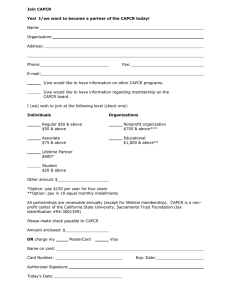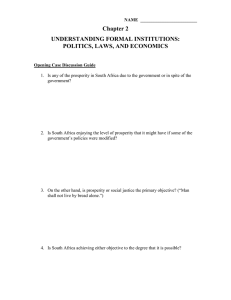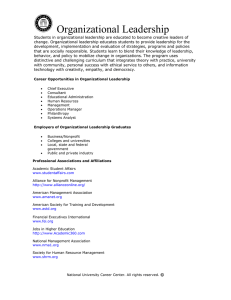Detailed Study Methodology
advertisement

About This Study—The Detailed Research Methodology The Arts & Economic Prosperity IV study was conducted by Americans for the Arts to document the economic impact of the nation’s nonprofit arts and culture industry. The study focuses on nonprofit arts and culture organizations and their audiences, but takes an inclusive approach that accounts for the uniqueness of different localities. Public arts councils, government arts organizations, university-based presenting facilities/institutions are included, as are select programs embedded within another organization such as a library (provided they have their own budgets and play substantial roles in the cultural life of communities). The study excludes spending by individual artists and the for-profit arts and entertainment sector (e.g., Broadway or the motion picture industry). Detailed expenditure data was collected from 9,721 nonprofit arts and culture organizations and 151,802 of their attendees. The project economists, from the Georgia Institute of Technology, constructed input-output models for each study region to provide specific and reliable economic impact data about the nonprofit arts and culture industries, specifically full-time equivalent jobs, household income, and local and state government revenue. This allows the uniqueness of each economy to be reflected in the findings. The Local, Regional, and Statewide Study Partners Americans for the Arts published a “Call for Participants” in 2010, seeking communities interested in participating in the Arts & Economic Prosperity IV study. Of the more than 200 communities that expressed interest, 182 agreed to participate. The 182 study regions include 139 individual cities and counties, 31 multi-city or multi-county regions, 10 states, and two arts districts. They represent all 50 U.S. states and the District of Columbia. The diverse communities range in population (1,600 to four million) and type (small rural to large urban). The research partners agreed to complete four participation criteria: 1) identify and code the comprehensive universe of nonprofit arts and culture organizations located in their study region; 2) assist with the collection of detailed financial and attendance information from those organizations, and review the information for accuracy; 3) conduct audience-intercept surveys at a broad, representative sample of cultural events that take place in their study region; and 4) pay a modest cost-sharing fee. No community was refused participation for an inability to pay the cost-sharing fee. Definition of the Nonprofit Arts and Culture Sector Each of the 182 study regions identified the comprehensive universe of eligible nonprofit arts and culture organizations that are located in the region. Eligibility was determined using the Urban Institute’s National Taxonomy of Exempt Entities (NTEE) coding system as a guideline. The NTEE system—developed by the National Center for Charitable Statistics at the Urban Institute—is a SOURCE: Arts and Economic Prosperity IV, Americans for the Arts, 2012. For more information, visit www.AmericansForTheArts.org/EconomicImpact. A-2 definitive classification system for nonprofit organizations recognized as tax exempt by the Internal Revenue Code. This system divides the entire universe of nonprofit organizations into 10 Major categories, including “Arts, Culture, and Humanities.” The Urban Institute reports that 113,000 nonprofit arts and culture organizations were registered with the IRS in 2010, up from 94,450 in 2005. Below is a complete list of the 43 NTEE “Arts, Culture, and Humanities” subcategories that are included in the Arts & Economic Prosperity IV study analysis. A01 – Alliances and Advocacy A02 – Management and Technical Assistance A03 – Professional Societies and Associations A05 – Research Institutes and Public Policy Analysis A11 – Single Organization Support A12 – Fund Raising and Fund Distribution A19 – Support (not elsewhere classified) A20 – Arts and Culture (general) A23 – Cultural and Ethnic Awareness A24 – Folk Arts A25 – Arts Education A26 – Arts and Humanities Councils and Agencies A27 – Community Celebrations A30 – Media and Communications (general) A31 – Film and Video A32 – Television A33 – Printing and Publishing A34 – Radio A40 – Visual Arts (general) A50 – Museums (general) A51 – Art Museums A52 – Children’s Museums A53 – Folk Arts Museums A54 – History Museums A56 – Natural History and Natural Science Museums A57 – Science and Technology Museums A60 – Performing Arts (general) A61 – Performing Arts Centers A62 – Dance A63 – Ballet A65 – Theatre A68 – Music A69 – Symphony Orchestras A6A – Opera A6B – Singing and Choral Groups A6C – Bands and Ensembles A6E – Performing Arts Schools A70 – Humanities (general) A80 – Historical Organizations (general) A82 – Historical Societies and Historic Preservation A84 – Commemorative Events A90 – Arts Services (general) A99 – Arts, Culture, and Humanities (miscellaneous) In addition, the 182 study communities were encouraged to include other types of eligible organizations if they play a substantial role in the cultural life of the community or if their primary purpose is to promote participation in, appreciation for, and understanding of the visual, performing, folk, and media arts. These include government-owned or government-operated cultural facilities and SOURCE: Arts and Economic Prosperity IV, Americans for the Arts, 2012. For more information, visit www.AmericansForTheArts.org/EconomicImpact. A-3 institutions, municipal arts agencies and councils, private community arts organizations, unincorporated arts groups, living collections (such as zoos, aquariums, and botanical gardens), university presenters, and arts programs that are embedded under the umbrella of a non-arts organization or facility (such as a community center or church). In short, if it displays the characteristics of a nonprofit arts and culture organization, it is included. For-profit businesses and individual artists were excluded from this study. Collection of Data from Eligible Arts and Culture Organizations To collect the required financial and attendance information from eligible organizations, researchers implemented a multi-pronged data collection process. In 131 of the 182 study regions, researchers used a web-based organizational expenditure questionnaire designed to collect detailed information about each organization’s fiscal year that ended during 2010. The questionnaire requested detailed information about more than 40 itemized organizational expenditure categories including labor, local and non-local artist fees, contracted services, operations, materials, facilities, and asset acquisition/capital expense. In addition, the questionnaire requested itemized information about organizational revenues, event attendance, volunteerism, in-kind contributions, and staff size. The remaining 51 study regions are located in one of 10 states (Arizona, California, Illinois, Maryland, Massachusetts, Michigan, New York, Ohio, Pennsylvania, and Rhode Island), each of which participated in the Cultural Data Project (CDP) during fiscal year 2010. The CDP is a unique system that enables arts and cultural organizations to enter financial, programmatic, and operational data into a standardized online form. In order to reduce the survey-response burden on eligible organizations, and because the CDP collects the detailed information required for this economic impact analysis, researchers used confidential CDP data in lieu of the web-based organizational expenditure survey instrument in these 51 study regions. The CDP data used for the Arts & Economic Prosperity IV study was provided by the Cultural Data Project, a collaborative project of the Greater Philadelphia Cultural Alliance, The Greater Pittsburgh Arts Council, Pennsylvania Council on the Arts, The Pew Charitable Trusts, The William Penn Foundation, and The Heinz Endowments (in each participating state, the CDP is also the result of a collaborative partnership of public and private funders and advocacy agencies), created to strengthen arts and culture by documenting and disseminating information on the arts and culture sector. Any interpretation of the data is the view of Americans for the Arts and does not necessarily reflect the views of the Cultural Data Project. For more information on the Cultural Data Project, visit www.culturaldata.org. The primary data collection efforts were supplemented with an abbreviated one-page version of the proprietary organizational expenditure questionnaire. The abbreviated version of the survey requested category totals only (rather than detailed, itemized financial information). In order to increase the overall response rates, all 182 study communities distributed the abbreviated one-page survey to any eligible organizations that declined to participate in either the full organizational expenditure survey or the CDP. SOURCE: Arts and Economic Prosperity IV, Americans for the Arts, 2012. For more information, visit www.AmericansForTheArts.org/EconomicImpact. A-4 Using all three methods of data capture, information was collected from a total of 9,721 eligible nonprofit arts and culture organizations and programs for this study. Response rates among all the 182 study regions averaged 43.2 percent and ranged from 5.3 percent to 100 percent. Responding organizations had budgets ranging from a low of $0 to a high of $239.7 million. It is important to note that each study region’s results are based solely on the actual survey data collected. No estimates have been made to account for non-respondents. Therefore, the less-than-100 percent response rates suggest an understatement of the economic impact findings in most of the individual study regions. The questionnaires used for all three methods of organizational data collection can be found in Appendix C of the Arts & Economic Prosperity IV National Statistical Report. Collection of Data from Arts and Culture Audiences Audience-intercept surveying, a common and accepted research method, was conducted in all 182 study regions in order to capture information about spending by audiences at nonprofit arts and culture events. Patrons were asked to complete a short survey while attending an event. Researchers provided the local, regional, and statewide study partners with comprehensive and detailed guidelines for collecting a random sample of surveys from attendees to a broad range of cultural events, performances, and exhibits taking place in each study region during 2011. Surveys were collected throughout the calendar year (to guard against seasonal spikes or drop-offs in attendance) as well as at a broad range of both paid and free events (a night at the opera will typically yield more spending than a Saturday children’s theater production or a community festival, for example). The study partners mailed or shipped the completed original surveys to Americans for the Arts. Researchers completed the coding and data entry of all surveys. The surveys were then subjected to a rigorous data cleaning procedure. Surveys were removed if the respondent did not provide either the ZIP code of his/her primary home, or their primary reason for being in the study region. With neither of those two data points, the respondent’s residency status could not be determined. Surveys were removed if the respondent reported that he/she is younger than 18 years of age. Surveys were removed if the respondent reported that his/her immediate travel party spent more than seven nights away from their primary residence(s) as a result of attending the cultural event where they were surveyed. Surveys were removed if the respondent reported that his/her immediate travel party included more than 12 people. Surveys were removed if the respondent reported that his/her immediate travel party spent more than $500 per person as a result of attending the cultural event where they were surveyed. SOURCE: Arts and Economic Prosperity IV, Americans for the Arts, 2012. For more information, visit www.AmericansForTheArts.org/EconomicImpact. A-5 A total of 151,802 valid audience-intercept surveys were collected. The randomly selected respondents provided itemized expenditure data on attendance-related activities such as meals, gifts and souvenirs, local ground transportation, and lodging. Using total attendance data for 2010 (collected from the participating eligible organizations), standard statistical methods were then used to derive a reliable estimate of total arts event-related expenditures by attendees in each study region. The respondents provided information about the entire party with whom they were attending the event. With an overall average travel party size of 2.69 people, these survey data actually represents the spending patterns of more than 408,000 attendees. The questionnaires used for audience-intercept data collection can be found in Appendix C of the Arts & Economic Prosperity IV National Statistical Report (provided in both the English and Spanish languages, as well as in a large font format for the visually impaired). Economic Analysis A common theory of community growth is that an area must export goods and services if it is to prosper economically. This theory is called “economic-base theory,” and it depends on dividing the economy into two sectors: the export sector and the local sector. Exporters such as automobile manufacturers, hotels, and department stores obtain income from customers outside of the community. This “export income” then enters the local economy in the form of salaries, purchases of materials, dividends, and so forth, and becomes income to residents. Much of it is re-spent locally; some, however, is spent for goods imported from outside of the region. The dollars re-spent locally have a positive economic impact as they continue to circulate through the local economy. The dollars spent non-locally cease having a local economic impact. This theory applies to arts organizations as well as to other producers. Studying Economic Impact Using Input-Output Analysis To derive the most reliable economic impact data, input-output analysis is used to measure the impact of expenditures by nonprofit arts and culture organizations and their audiences. This is a highly regarded type of economic analysis that has been the basis for two Nobel Prizes in economics. The models are systems of mathematical equations that combine statistical methods and economic theory in an area of study called econometrics. The analysis traces how many times a dollar is re-spent within the local economy before it leaks out, and it quantifies the economic impact of each round of spending. This form of economic analysis is well suited for this study because it can be customized specifically to each community, region, or state. An input-output model was customized for each of the 182 participating study regions based on the local dollar flow between 533 finely detailed industries within its economy. This was accomplished by using detailed data on employment, incomes, and government SOURCE: Arts and Economic Prosperity IV, Americans for the Arts, 2012. For more information, visit www.AmericansForTheArts.org/EconomicImpact. A-6 revenues provided by the U.S. Department of Commerce (County Business Patterns, Regional Economic Information System, and Survey of State and Local Finance), local tax data (sales taxes, property taxes, and miscellaneous local option taxes), as well as the survey data from the responding nonprofit arts and culture organizations and their audiences. The Input-Output Modeling Process The input-output model is based on a table of 533 finely detailed industries showing local sales and purchases. The local and state economy of each community is researched so the table can be customized for each community. The basic purchase patterns for local industries are derived from a similar table for the U.S. economy for 2007 (the latest detailed data available from the U.S. Department of Commerce). The table is first reduced to reflect the unique size and industry mix of the local economy, based on data from County Business Patterns and the Regional Economic Information System of the U.S. Department of Commerce. It is then adjusted so that only transactions with local businesses are recorded in the inter-industry part of the table. This technique compares supply and demand and estimates the additional imports or exports required to make total supply equal total demand. The resulting table shows the detailed sales and purchase patterns of the local industries. The 533-industry table is then aggregated to reflect the general activities of 32 industries plus local households, creating a total of 33 industries. To trace changes in the economy, each column is converted to show the direct requirements per dollar of gross output for each sector. This direct-requirements table represents the “recipe” for producing the output of each industry. The economic impact figures for Arts & Economic Prosperity IV were computed using what is called an “iterative” procedure. This process uses the sum of a power series to approximate the solution to the economic model. This is what the process looks like in matrix algebra: T = IX + AX + A2X + A3X + ... + AnX T is the solution, a column vector of changes in each industry’s outputs caused by the changes represented in the column vector X. A is the 33 by 33 direct requirements matrix. This equation is used to trace the direct expenditures attributable to nonprofit arts organizations and their audiences. A multiplier effect table is produced that displays the results of this equation. The total column is T. The initial expenditure to be traced is IX (I is the identity matrix, which is operationally equivalent to the number 1 in ordinary algebra). Round 1 is AX, the result of multiplying the matrix A by the vector X (the outputs required of each supplier to produce the goods and services purchased in the initial change under study). Round 2 is A2X, which is the result of multiplying the matrix A by Round 1 (it answers the same question applied to Round 1: “What are the outputs required of each supplier to produce the goods and services purchased in Round 1 of this chain of events?”). Each of columns 1 through 12 in the multiplier effects table represents one of SOURCE: Arts and Economic Prosperity IV, Americans for the Arts, 2012. For more information, visit www.AmericansForTheArts.org/EconomicImpact. A-7 the elements in the continuing but diminishing chain of expenditures on the right side of the equation. Their sum, T, represents the total production required in the local economy in response to arts activities. Calculation of the total impact of the nonprofit arts on the outputs of other industries (T) can now be converted to impacts on the final incomes to local residents by multiplying the outputs produced by the ratios of household income to output and employment to output. Thus, the employment impact of changes in outputs due to arts expenditures is calculated by multiplying elements in the column of total outputs by the ratio of employment to output for the 32 industries in the region. Changes in household incomes, local government revenues, and state government revenues due to nonprofit arts expenditures are similarly transformed. Calculation of the National Estimates To derive the national estimates, the 139 individual city/county study regions only—multi-city and multi-county regions, states, and individual arts districts are excluded from this analysis—were first stratified into six population groups, and an economic impact average was calculated for each group. Second, the nation’s largest 13,366 cities were assigned to one of the six groups based on its population, as supplied by the U.S. Census Bureau. Third, each individual study region was assigned the economic impact average for its population group. Finally, the values of the study regions were added together to determine the national economic impact findings. Several outlier study regions were removed from the calculations of the national estimates due to their comparably high levels of economic activity in their population categories (the outlier regions are identified in the applicable data tables located in Appendix B of the Arts & Economic Prosperity IV National Statistical Report). SOURCE: Arts and Economic Prosperity IV, Americans for the Arts, 2012. For more information, visit www.AmericansForTheArts.org/EconomicImpact. A-8




